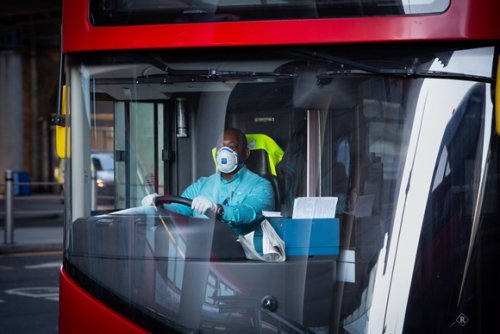London’s buses are to begin returning to front-door boarding, with customers required to touch in with Oyster, contactless and concessionary cards, Transport for London (TfL) has confirmed.
The move follows extensive work by a multidisciplinary team from UCL’s Centre for Transport Studies and Department of Civil, Environmental & Geomatic Engineering to assess the risks for drivers in their cabs and close work with bus operators and the UNITE union to develop improvements to the screens beside bus drivers.
The UCL analysis finds that the steps that TfL has taken – by adding a film layer to screens and sealing off gaps around the screen as a whole, including around the Oyster reader – substantially reduces the risk to drivers of contracting coronavirus from customers. This is on top of the rigorous cleaning regime, which sees cabs and handrails, along with other regularly touched areas, treated with hospital-grade anti-viral disinfectant.
From Saturday 30 May, passengers will start to see signage on 124 bus routes instructing them to board using the front door and use their Oyster, contactless or concessionary cards. Front-door boarding will be reinstated on further bus routes as soon as possible, and it is anticipated that all London buses will have returned to front-door boarding by mid-June.
Reverting to pre-pandemic arrangements will improve social distancing for customers entering or exiting the bus by reinstating the traditional flows on and off the bus, and while queuing at stops or stations, as well as giving TfL accurate information to ensure it is providing the service needed to enable safe travel for all.
To further ensure the safety of customers and bus drivers, new limits to the number of customers on board at any one time will be introduced. This will help customers to observe the national guidance to maintain a two-metre distance between them and others wherever possible.
Double-decker buses will be able to carry 20 customers. Single-decker buses, depending on the size of the bus, will carry between six and 10 customers. The driver will have discretion to allow more customers on board if they are travelling in households or groups.
Heidi Alexander, Deputy Mayor for Transport, said: “The safety of our transport workers and passengers is absolutely paramount.
“Working closely with unions, TfL has introduced a range of measures to improve safety including putting in place an enhanced anti-viral cleaning regime across the network, applying a protective film to the Perspex screen of bus driver cabs to seal off holes and preventing passengers sitting next to bus drivers. All frontline staff have also been offered simple face masks.
“From this weekend passengers will be asked to resume boarding through the front door on some of our buses. All buses where we are reverting to front door boarding have had additional work carried out to seal off the opening at the bottom of the safety screen which was historically used for cash payments. Scientific advice has confirmed that it is safe for front door boarding to resume on these buses thanks to these improvements. These enhancements are urgently being rolled out across the network on a route-by-route basis.
“Our message to Londoners is clear though – please work from home and travel on foot or bike if you can. Public transport is a precious resource that should be preserved for those who need it. But if you absolutely have to travel on our network, wear a face mask, avoid the busiest times and respect the new arrangements to enable everyone to travel safely.”
Claire Mann, TfL’s Director of Bus Operations, said: “Our number-one focus is always the safety of everyone travelling or working on our transport network. Following the outcomes of the research by UCL’s Centre for Transport Studies, and through working closely with UNITE and the bus operators, we now know that the measures we have introduced to add extra protection to the driver’s cab have improved safety.
“Bus drivers have played a heroic role during the pandemic, ensuring that essential travel has been maintained and that NHS workers have been able to get to work and save lives. The bus network is now supporting London’s safe and sustainable recovery by ensuring that customers can more easily maintain a safe social distance.
“Our message remains: please follow the Government guidance and work from home and avoid public transport where possible. If you do need to travel, please consider walking or cycling where possible. If using public transport is essential, please do what you can to protect others. Wear a face covering, avoid the busiest times and respect our staff and your fellow passengers.”
In line with new Government advice, everyone who can work from home should continue to do so. Public transport should be avoided wherever possible to free up the limited space available to those who have no alternative way to travel. For their own safety and that of others, people who must travel and cannot walk or cycle should:
-
- Help maintain social distancing by keeping a two-metre distance wherever possible by sitting next to the window and leaving empty rows in front and behind
- Allow people to alight the bus before boarding
- Not dwell near the driver or try to use seats closest to the driver, which will remain out of use for customers
- Make use of all available space, including the upper deck, and not stand
- Wait for the next bus if the bus they attempt to board has reached its safe capacity
- Be considerate to transport staff and follow their instructions, including to respect the new capacity limits on buses
- Avoid peak times, 05:45-08:15 and 16:00-17:30, wherever possible
- Wear a face covering
Walking and cycling has a key role to play in ensuring that everyone who needs to travel can do so safely. TfL is enabling this vital growth of walking and cycling by delivering the London Streetspace programme. This will rapidly transform London’s streets to accommodate a possible ten-fold increase in cycling and five-fold increase in walking and will:
-
-
- Transform parts of central London into one of the largest car-free zones in any capital city in the world
- Widen pavements at local pinch points across London
- Create a new temporary strategic cycling network for Londoners
-
Throughout the pandemic, TfL has been using additional hospital-grade anti-viral fluid across the transport network with particular attention paid to all regular ‘touch points’, such as handrails, doors and steering wheels. TfL and London’s bus operators have ensured that all London bus drivers have masks available to them, and in line with the Government and Mayor’s advice, TfL is also urging all customers to use a face covering when using public transport to help control the spread of coronavirus.


